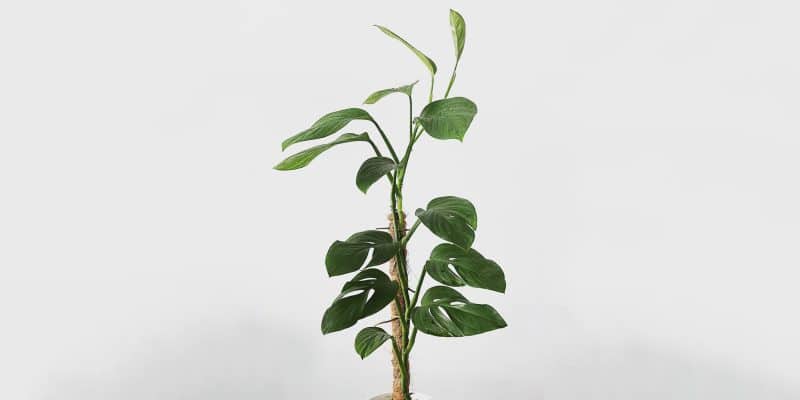If you’re a plant lover who enjoys growing impressive and eye-catching greenery in your home, then it’s time to get acquainted with a showstopper: Monstera pinnatipartita.
This spectacular houseplant is known for stunning split leaves that add an exotic touch to your home. You can think of it as the lesser-known cousin of the wildly popular Monstera deliciosa.
In this article, we’ll cover Monstera pinnatipartita care, explore the unique beauty and versatility of this stunning tropical plant, and uncover the secrets for successfully growing it.
Table of Contents
Monstera Pinnatipartita Plant Care Guide
History, habitat, and characteristics
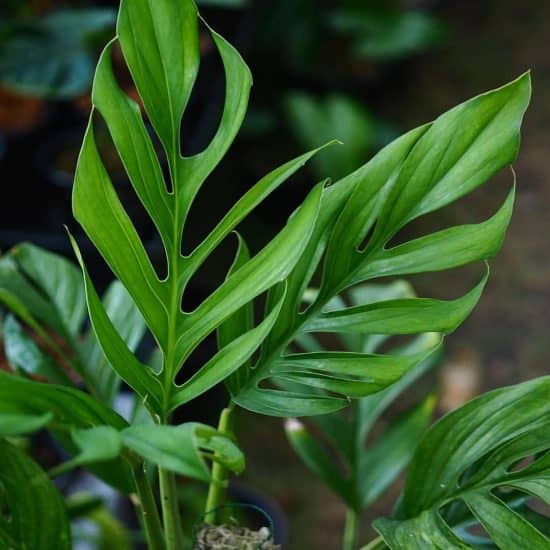
Monstera pinnatipartita is a mysterious, enchanting plant that brings the essence of the jungle straight to your living space. It may not be as well known as other Monstera, but it’s an undeniably alluring houseplant from the tropical regions of Central and South America.
Although it’s a cousin of the well-loved Swiss cheese plant (Monstera deliciosa), Monstera pinnatipartita has its own set of unique features that make it stand out.
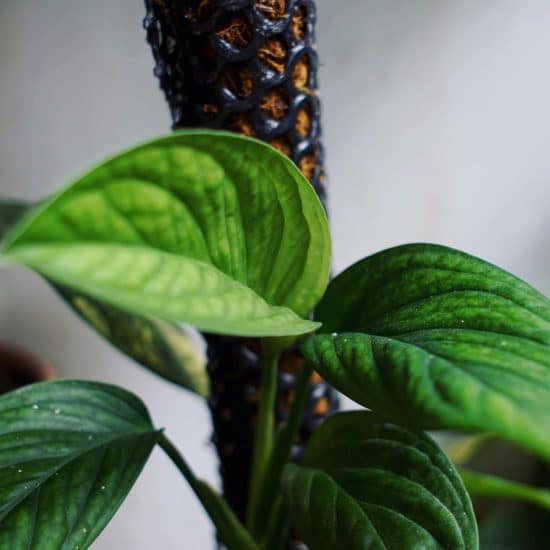
As the plant matures, its leaves transform from a juvenile look, imitating the deep veins of the Monstera Peru, until they eventually split, giving it a striking jungle vibe.
The internodal spacing of this plant changes too. You’ll find closer spacing at the top of the stem and wider spacing at the bottom, creating a visually appealing spectacle as the plant vines upwards.
If you’re thinking this amazing plant is hard to handle, don’t worry! Monstera pinnatipartita is incredibly adaptable to various growth habits. You can train it to grow upwards, cascade downwards, or even maintain a bushier, compact form.
You don’t have to be an experienced gardener to take care of this exotic plant. With a bit of love and attention, even beginner plant enthusiasts can bask in the beauty of the Monstera pinnatipartita.
Light
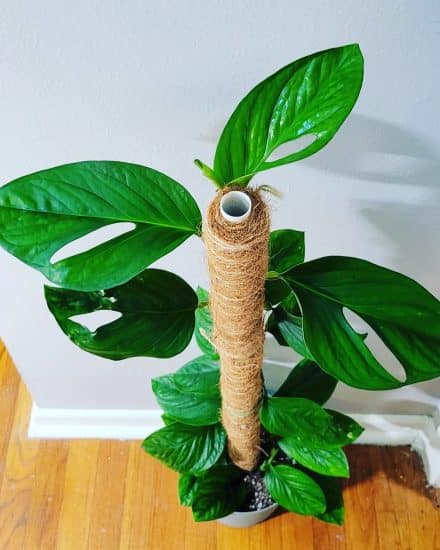
Navigating the indoor lighting requirements for your Monstera pinnatipartita can be a breeze with the right guidance.
Because this plant is native to tropical rainforests where it grows beneath the canopy, it thrives best in bright, indirect light, so moderate lighting situations are just the ticket.
Monstera pinnatipartita does great when placed behind a larger plant that offers shade or near a window where it can benefit from plenty of ambient natural light.
If your Monstera pinnatipartita isn’t receiving enough light, you’ll notice the leaves looking a bit dull and its growth may slow down. On the other hand, too much direct sunlight can lead to scorched leaves and unappealing holes.
Our lighting tips:
- Choose a location with bright, indirect light; for example, near a window with sheer curtains or behind another plant that offers shade.
- Stay away from direct sun to avoid scorching and small holes appearing on the leaves.
- If you find your plant languishing in a low-light area, introducing artificial light sources (such as an LED or full-spectrum grow light) can work wonders for growth.
- Keep a close eye on the color and appearance of your plant’s leaves; any discoloration, dullness, or holes can signal lighting issues.
Water
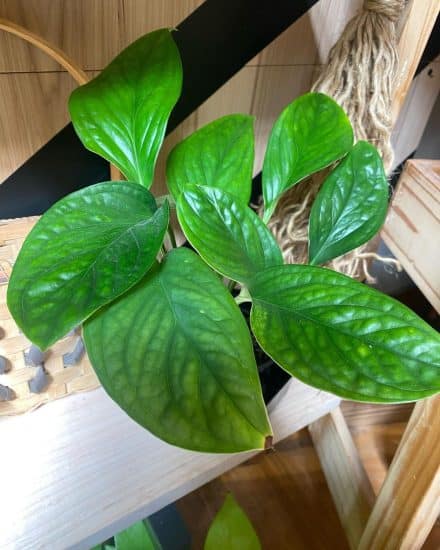
Watering your Monstera pinnatipartita the right way is crucial to keeping it healthy and thriving. Similar to its famous relative, the split-leaf philodendron, this unique monstera variety has particular watering needs to ensure it grows happily.
You’ll need to let the soil almost dry out before providing a deep, generous watering. In the colder winter months, you can water less regularly, but in the warmer spring and summer, aim for once a week. A terracotta pot is a smart choice to both help retain moisture and prevent overwatering.
When your Monstera pinnatipartita doesn’t receive enough water, the oldest leaves (those at the bottom) will turn crispy or yellow and curl up or wilt. If you notice this happening, don’t fret – simply increase your watering frequency and remove any yellow leaves to keep pests from moving in.
However, too much water can also cause problems, such as yellowing leaves and mushy stems. If you start to see brown leaf tips followed by small brown and black spots, it’s time to cut back on watering and let the soil dry out properly.
Temperature and humidity
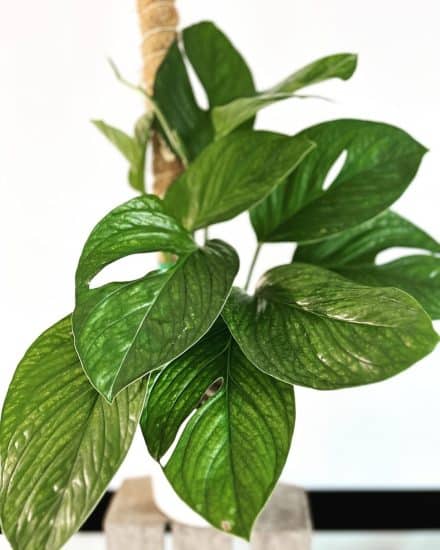
Tropical plants like Monstera pinnatipartita enjoy an equally tropical environment, so aim for a consistent indoor temperature between 65-80°F. It’s okay for the temperature to drop slightly during nighttime, but make sure to protect it from cold drafts, which can cause damage to roots and leaves.
If a window or doorway frequently exposes your plant to cold air, consider moving it to a more sheltered spot.
High humidity is where Monstera pinnatipartita truly thrives. It benefits greatly from being placed near a humidifier or in a room with naturally high humidity levels, such as a bathroom with a window. Aim for humidity levels around 50% or higher to replicate its natural habitat and encourage healthy growth.
Signs that your Monstera pinnatipartita may be receiving too much humidity include yellowing leaves and mold growth. On the other hand, if it’s not getting enough humidity, you might notice drooping leaves or brown, crispy leaf tips. Adjusting the humidity levels accordingly will help keep your plant healthy and happy.
Temperature and humidity tips:
- Maintain indoor temperatures between 65-80°F, avoiding cold drafts and sudden temperature changes.
- Aim for a humidity level of 50% or higher, using a humidifier or placing your plant in a naturally humid room.
- During winter, be sure to protect your plant from cold temperatures when transporting it, even for short periods.
Soil and planting
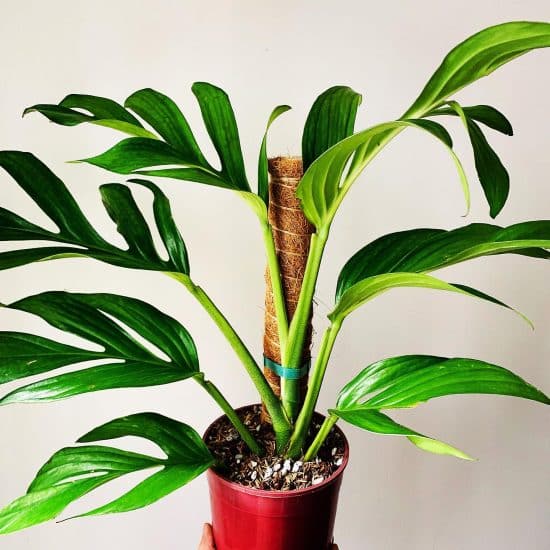
For Monstera pinnatipartita, the ideal soil mix consists of a chunky aroid blend, which may include orchid bark, perlite, horticultural charcoal, coconut husks, LECA, and a small amount of potting soil. This tropical plant isn’t overly particular about its soil, as long as it’s fertile and doesn’t retain excessive moisture.
Fertilize the plant at least once a month during the active growing season or twice a month in tropical regions.
Repotting
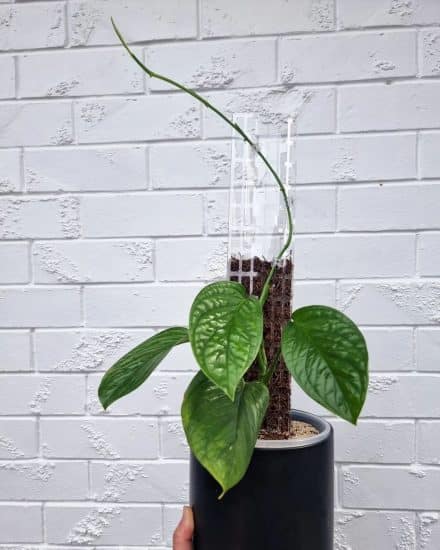
Monstera pinnatipartita can have an extensive root system, so it’s important to choose an appropriately sized pot when repotting. Look for a deep pot to prevent any issues and encourage proper aeration. This is also a great opportunity to refresh your plant’s soil with an improved mix, ensuring optimal growth and health of your Monstera pinnatipartita plant.
Be mindful not to increase the pot size by too much. A couple of inches in diameter and height is plenty. Any more than that and you can end up overwatering.
Propagation
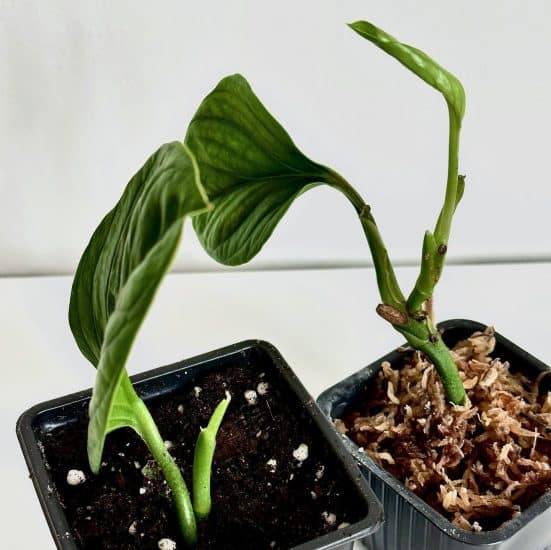
Propagating your Monstera pinnatipartita can be a super fun and rewarding experience. Just follow these easy steps, and voilà!
- Free your plant from any ties or attachments it might have to a sphagnum moss pole. This way, you can access the stem without causing any damage to your leafy friend.
- Have a good look at the stem and figure out which part you want to use for propagating your new Monstera Pinnatipartita plant. Picking a cutting with aerial roots is a great way to boost your success rate.
- Make your cuts beneath single nodes. Don’t forget to use sterilized shears for this job!
- Give your cuttings space by re-potting each in its own separate pot filled with fresh soil mix or rooting medium. This way, they won’t fight over resources and can grow happily on their own.
- Reattach your parent plant onto the grow pole using plant velcro.
- Water your cuttings with a top-notch nutrient solution like Clonex Clone Solution, which helps those roots grow super fast.
- Plant your newly rooted cuttings straight into soil or water (your choice!). A soil mix with fern fiber does wonders for root stability.
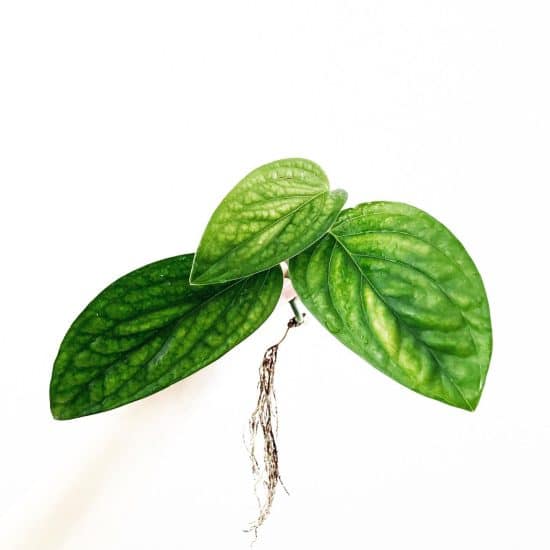
Our tips:
- Go for a cutting with aerial roots to up your chances of propagation success.
- Find a bright spot with indirect light to help your new cutting get comfy and grow roots faster. And don’t forget to keep the soil moist!
Common Issues
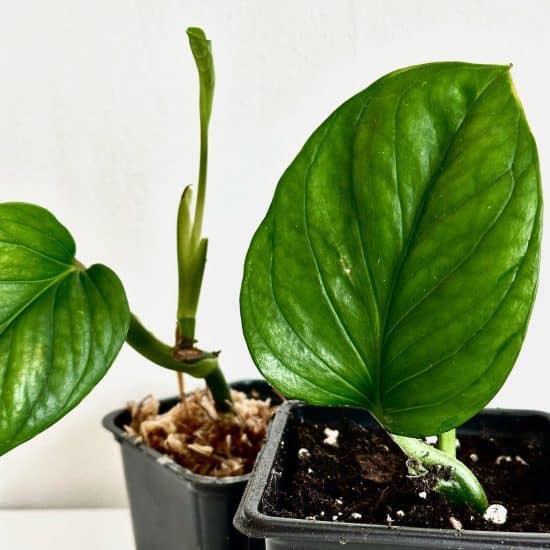
Slow growth
Spot the problem: If you notice slow growth (we’re talking weak, leggy stems and smaller leaves), it could be that your pot is too shallow. Remember, this plant needs some space for its roots to spread out and do their thing.
Here’s the fix: Simply find a slightly deeper pot to give your green friend more room. When repotting, gently untangle and spread out the roots. Use a well-draining soil mix with organic matter (like coco coir), and watch your monstera pinnatipartita flourish as it grows!
Dropping lower leaves
Spot the problem: If your monstera plant is dropping leaves, it might be getting too much direct sunlight. The poor thing’s trying to protect itself from sunburn.
Here’s the fix: Just move your plant to a spot with bright, indirect sunlight. If you can’t move it, no problem. Grab a sheer curtain and let it filter that sunshine for your monstera. Also, make sure you’re giving it enough water (but not too much!). Keep the soil moist but let the top inch dry out between waterings.
Curling leaves
Spot the problem: Along with leaf curling, keep an eye out for yellowing, wilting leaves and a musty smell. Those curled, limp leaves could be a waterlogged root SOS signal.
Here’s the fix: Let’s get to work. First, gently take your Monstera pinnatipartita out of its pot and snip off any unhealthy roots. Then, repot it into well-draining soil. Allow the soil to dry a bit between waterings, and don’t forget to empty that saucer beneath the pot. To fix those curled leaves, keep an eye on your watering habits and be sure to keep your plant in bright, indirect light. It’ll be back on track in no time!
Pests and diseases
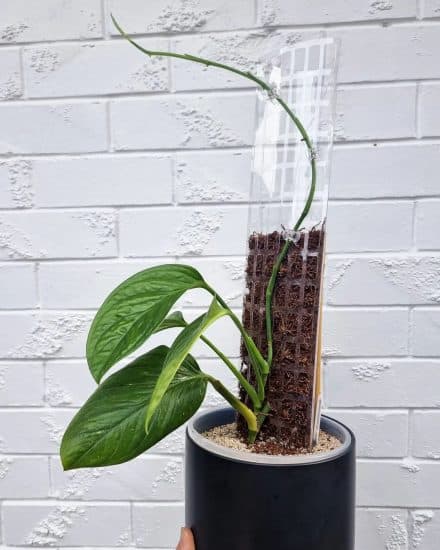
Root Rot
When it comes to identifying root rot, look out for yellowing leaves, wilting, and even a not-so-pleasant smell coming from the roots or wet soil.
Now, to fix this situation, first gently remove your monstera from its pot and rinse the roots to get rid of any loose soil. Have a close look at those roots and trim off any mushy, slimy, or discolored bits with some sterilized scissors (remember to clean them before and after use).
Time to repot your Monstera pinnatipartita! Fresh, well-draining soil with some added perlite, pumice, or sphagnum moss is perfect for increased aeration. Grab a deep terracotta pot, which helps prevent future issues. And don’t forget – water your Monstera only when the top 1 to 2 inches of soil feels dry, and make sure there’s no standing water.
Pests
Monstera pinnatipartita can sometimes attract aphids, spider mites, and mealybugs. Regularly checking your plant is essential to catch those sneaky pests early on. Keep an eye out for small discolored spots on the leaves, webbing, and sticky residue.
If you do spot pests, first things first: isolate your Monstera from other grouping plants. This is essential to avoiding a full-blown infestation. For mild cases, gently remove the pests using a damp cloth or a soft toothbrush, being extra thorough and checking the undersides of leaves where they like to hide.
But if things have gotten more serious, it’s time for an insecticidal soap or neem oil treatment. Just follow the instructions on the label, and you’ll be good to go! Keep an eye on your plant, and reapply the treatment as needed until those pests are history. Be sure to avoid any direct sunlight after you have applied a treatment.
Maintaining proper humidity levels and warm temperatures makes your monstera less inviting to pests like spider mites, who love dry conditions.
Conclusion
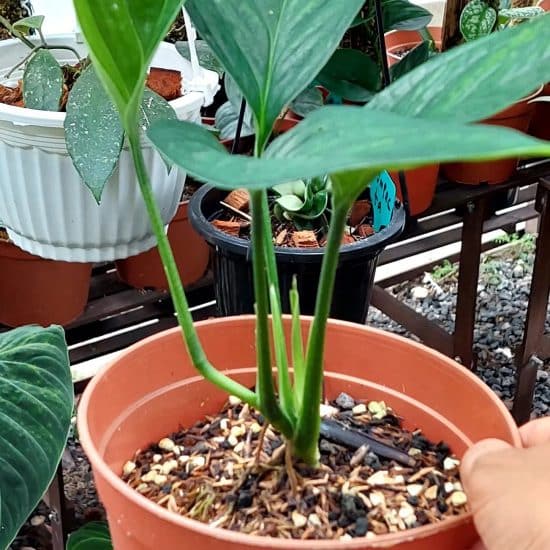
Now you’re equipped with all the knowledge you need to help this exotic beauty thrive in your home. Care for Monstera pinnatipartita well and this stunning houseplant will reward you with mesmerizing split leaves and an indoor tropical vibe.
Monstera pinnatipartita care summary:
- Provide bright, indirect light and keep it away from direct sunlight to avoid scorching the leaves.
- Water according to the season, allowing the top inch of soil to dry out between waterings.
- Maintain indoor temperature between 65-80°F and aim for a humidity level of 50% or higher.
- Use a chunky aroid mix for the soil and provide a deep pot with drainage holes.
- Fertilize monthly during the growing season and monitor for any signs of over-fertilization or poor soil.
We hope that you find our Monstera pinnatipartita care guide helpful. Don’t hesitate to reach out if you have any questions, and feel free to share this article with fellow plant enthusiasts.
Happy planting, and take care!
FAQ
Is Monstera pinnatipartita rare?
Yup, this captivating plant is considered rare, especially among typical houseplant collections. Its unique appearance, with signature pinnae that give it an almost sculptural quality, makes it a prized addition for any plant enthusiast. Be prepared to search a bit harder and potentially pay a higher price.
Are Monstera Siam and pinnatipartita the same?
While both monstera plants are captivating in their own right, Monstera Siam (Monstera karstenianum) and Monstera pinnatipartita are actually distinct species. Monstera Siam is commonly referred to as a “mini monstera” due to its close resemblane to Monstera deliciosa, but with smaller leaves. Monstera pinnatipartita, on the other hand, has its own unique leaf structure that sets it apart.
What is the difference between Monstera pinnatipartita and Monstera deliciosa?
Monstera pinnatipartita is rarer, with its unusual pinnae and large, oblong leaves that boast a glossy and intricate pattern. In contrast, Monstera deliciosa is a more widespread houseplant, known for its iconic split leaves and the delicious fruit it produces in the wild.
Does Monstera pinnatipartita need a pole?
Monstera pinnatipartita is a natural climber. It benefits from a little support to help it reach its full potential. By adding a moss pole, coconut coir pole, or any sturdy support, you not only provide stability to the plant, but also create a healthier environment that more closely mimics its natural habitat. Alternatively, you could also let it trail.
Can you grow monstera pinnatipartita outdoors?
Absolutely! Monstera pinnatipartita loves to stretch its gorgeous leaves outdoors, but it does best in specific conditions. Picture a warm, sunny spot with dappled shade, as direct sun can cause the leaves to scorch. You’ll want to place your monstera in a zone with an ideal temperature between 65°F and 85°F, making sure it’s well protected from harsh wind and frosty nights.
Think of these tropical beauties like sunbathers – they can’t resist basking in some rays, yet they know when it’s time to retreat to a cooler, shadier spot. Keep an eye on your monstera’s leaves, as they’ll often tell you if they’re content with their outdoor home.
How does Monstera pinnatipartita differ from the split leaf philodendron?
Monstera pinnatipartita and the split leaf philodendron are truly the botanical world’s dazzling doppelgangers. For some reason, fenestrated plants are often hard to distinguish, especially because they change as they mature.
A key distinction lies in their leaf patterns. Monstera pinnatipartita has curious, long leaves with distinctive pinnate cuts that run along the side, whereas the split leaf philodendron is famous for its large, iconic leaves with deep splits and holes resembling a Swiss cheese plant. Monstera pinnatipartita leaves also tend to have an enchanting shade of velvety deep green, setting it apart from its glossy-leaved cousin.

